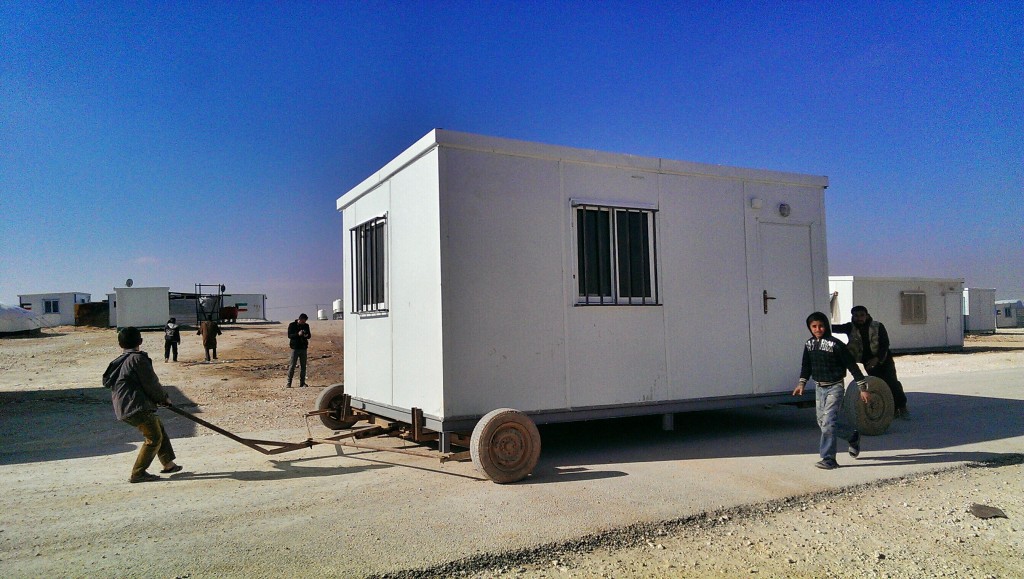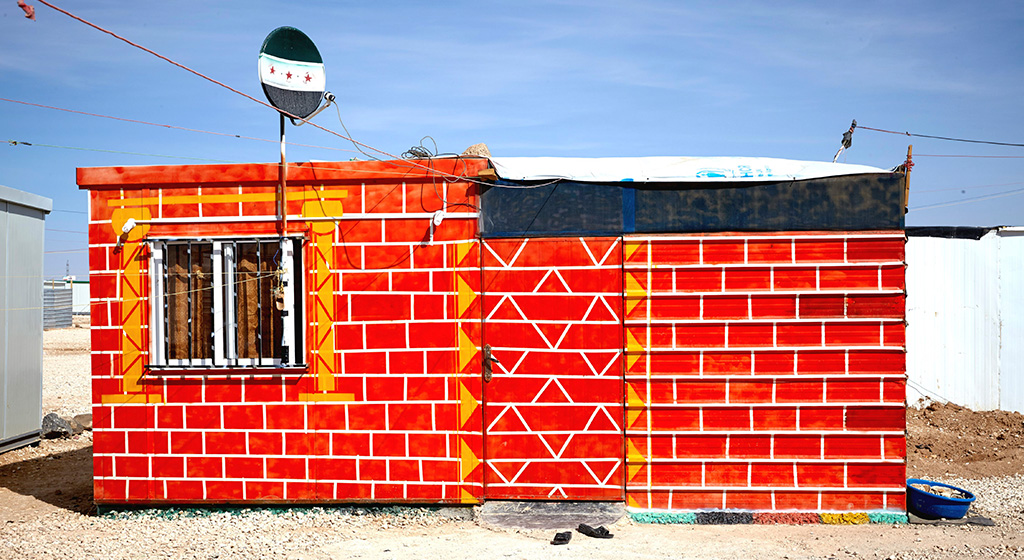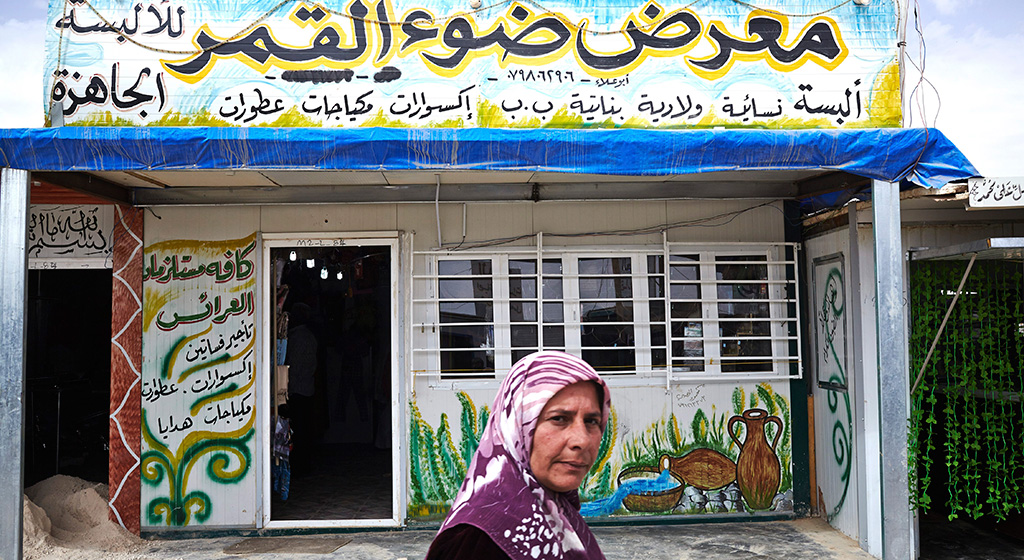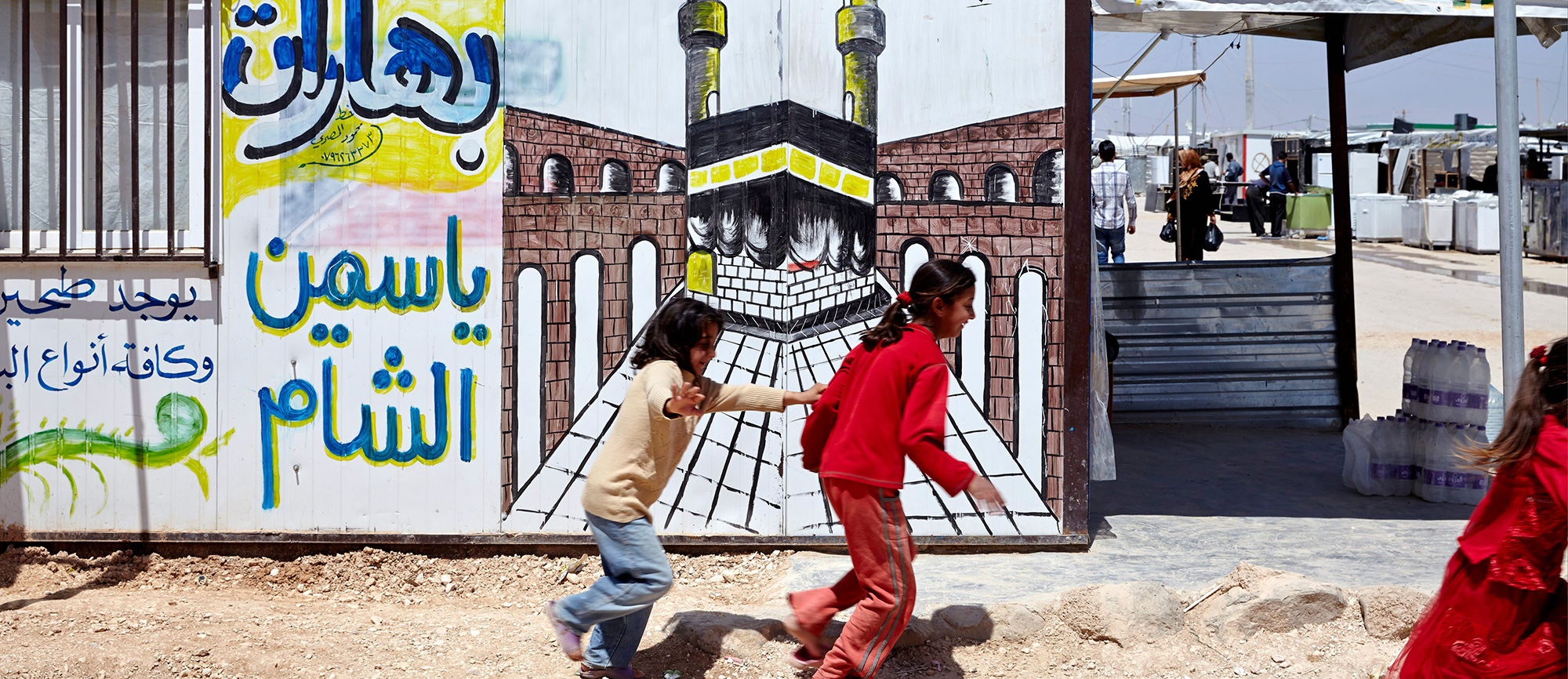1. Define challenges
Camp safety compromised by moved tents and shelters
Za’atari Refugee Camp in Jordan was set up in only nine days in July 2012. Almost immediately after it opened, thousands of Syrians began arriving at the dusty site every day. In the absence of proper shelters, each family was issued a tent, which were erected in a military grid structure, and pitched on a selected plot by UNHCR or one of its partner agencies. The more people arrived, the bigger the structure grew.
Once UNHCR and its partners received prefabricated shelters, families were issued these rather than tents. The shelters resemble caravans. Originally they were placed in the same location as the tents had stood. Had it been left entirely to humanitarian agencies, Za’atari would have expanded in an ordered, concentric manner.
But Syrian refugees had ideas of their own. They wanted to be able to choose their location, so that their tent or shelter stood close to their friends and relatives.

A family moving its home from one part of Za’atari camp to the other. Photo credit: Hesna Al Ghaoui
2. Identify solutions
Engaging refugees to organize relocation
A longstanding challenge for the humanitarian system has been finding ways that engage those traditionally assisted in a more participatory manner. Organizations have the intention to speak with refugees, but against the pressure to implement effective solutions quickly, those dialogues remain unrealized, and top-down interventions are rolled out. The same may have been true in Za’atari had Syrians not begun hacking the solutions provided to them from the very first day they arrived in the camp.
Families would watch as UNHCR or its partners set up the tent according to the military style grid. Then just as soon as the aid officials had moved on, the refugees would recruit a young Syrian to take the tent down, and move it to a location in the camp that was nearer to their relatives or friends – a location they had chosen.
Later, when the prefabricated shelters began being delivered instead of the tents, Syrians wanted to move these to their preferred location too. However, the caravans couldn’t simply be hoisted over a shoulder. They needed to be transported. So Syrian welders built a carting device out of wheels and fence posts, which they used to make large axles to move the shelters.

3. Test solutions
Incrementally moving toward a people-centered approach of assistance
UNHCR did not try to stop refugees relocating their shelters. And by being allowed to move, Syrians in Za’atari were able to change solutions provided for them to better suit their context, shifting development within the camp toward a more people-centered approach. After noticing the positive impact this organic movement was having on community spirit within the camp, UNHCR Jordan stopped pitching tents and merely distributed them.
However, at times refugees would place their tent or shelter in locations UNHCR Jordan and its partners had planned to use for public purposes, such as wastewater systems or schools. Or they would block paths that had been designated for ambulances. So although stopping Syrians from relocating would have gone against their interests, UNHCR Jordan needed to also maintain camp safety and ensure development.
The agency therefore began a dialogue with the refugees, and developed an informal version of urban planning within Za’atari. Syrians were left free to move their shelters, but within certain limits, such as keeping roads and public areas clear.

The organic movement of shelters was recognized as having a positive effect on community spirit within the camp. © UNHCR/Shawn Baldwin
4. Refine solutions
Refugees find ways to improve their shelters
Through this dialogue, UNHCR Jordan was able to organize the refugees’ improvisation, and Za’atari developed into an informal city at a pace stunning to see. Refugees in Za’atari were thus enabled to reconstruct the social structures they had been forced to abandon in Syria. Families reassembled. Neighbours reconnected. Even entire Syrian villages were re-forming themselves inside the camp. Ask any one of the 83,000 refugees currently living in Za’atari who their camp neighbour is, and often the answer will be the same their neighbour from back home in Syria.
And the entrepreneurialism of Syrians did not stop after they had relocated their shelters. Once they had their new homes where they wanted them to be, they set about modifying them to better suit their needs.
But materials available to them were limited. Syrians cannot build using bricks and mortar in Za’atari, because the camp must remain a temporary structure; and some refugees did not have enough funds to purchase alternative materials.
To aid them in their efforts, UNHCR provided refugees in Za’atari with five Jordanian dinars to purchase silicon, which was available in the camp market. The donation was small, but it was all that was needed to fill the gaps, literally and figuratively.
Syrians were thus able to reshape, restructure and expand their shelters. Without their application and creativity, Za’atari would never have become the place it now is. And even though the camp has not been receiving new refugees for around a year, Syrians ability and willingness to devise their own solutions remains important, as the civil war in Syria is now in its fifth year, and resources have become increasingly stretched.
The relocation of their tents, and transportation as well as modification of their shelters, demonstrate how refugees can improve their own situation with very little international aid. The fact that UNHCR had to intervene to ensure that their endeavours did not compromise camp safety and development, on the other hand, show that Syrians refugees in Za’atari continue to need support, even if that support serves mainly to establish rules and supply missing materials.

5. Scale solutions
Recognizing refugees’ potential as well as vulnerabilities
Za’atari camp exemplifies how entrepreneurial refugees can become their own innovators if permitted certain freedoms. The solutions they found for improving their shelters and living conditions were not particularly technologically advanced, but they were creative and context specific, and they perfectly reflected Syrians’ cultural norms. As such, the camp shows just how important it is to recognize not just the vulnerabilities of affected population, but also their abilities.

The dwelling modification case is just one example of how refugees are developing their own solutions throughout Za’atari camp. © UNHCR/Shawn Baldwin
Nonetheless, because the context of Za’atari camp is also very specific, UNHCR currently has no plans to roll out the shelter modifications project to other refugee camps. It is rare for a camp erected during emergency circumstances to have a community as practiced in trade and crafts as Za’atari’s inhabitants. Most of the Syrians that fled the civil war come from middle-income backgrounds, meaning they have more skills than the average refugee. They also have more demands, as the standards they are used to include clean, running water and homes wired for electricity. Those demands fuel their agency, which, with the direction of UNHCR, continues to contribute to the development of Za’atari camp.








